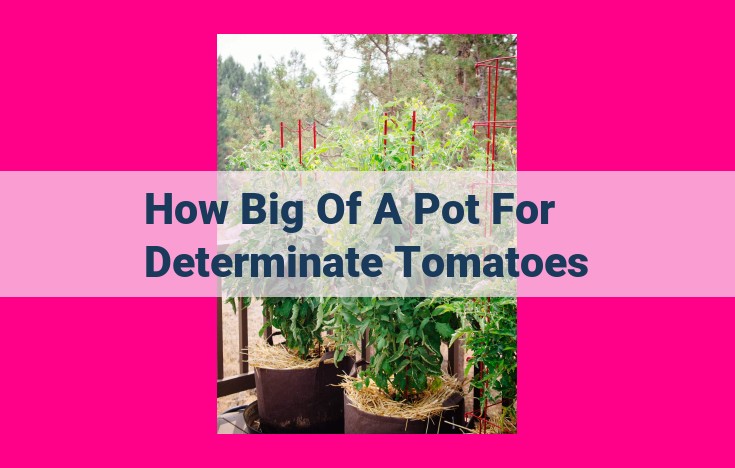Essential Factors For Cultivating Thriving Tomatoes: A Comprehensive Guide

Essential Factors for Growing Tomatoes
-
[…]
-
Plant Selection and Environment
- Pot Size: Determinate tomato varieties, which have a limited growth habit, can thrive in containers as small as 14-16 inches in diameter and 12 inches deep.
[…]
[…]
Essential Factors for Growing Tomatoes: Plant Selection and Environment
Growing tomatoes in pots is a rewarding experience that can provide you with fresh, homegrown produce. To ensure success, there are several key factors to consider when selecting your plants and creating an ideal environment for them to thrive.
Pot Size and Plant Variety:
The optimal pot size for your tomato plant depends on the variety you choose. Determinate tomato varieties, which have a limited growth habit, are ideal for containers, as they won’t outgrow the pot. Indeterminate tomato varieties, which can grow quite large, require a larger container to accommodate their spreading roots.
Soil and Drainage:
Tomatoes prefer well-drained soil that is rich in organic matter. This allows their roots to access the nutrients they need while preventing waterlogging, which can lead to root rot. Amending your potting mix with compost or manure will provide the necessary organic matter and nutrients.
Watering and Sun Exposure:
Water your tomato plants regularly, especially during warm and dry weather. The soil should be kept consistently moist but not soggy. Tomatoes thrive in areas with 6-8 hours of direct sunlight per day. Place them in a location that receives ample sunlight throughout the growing season.
Plant Maintenance: Nurturing Your Tomato Plants
As your tomato plants embark on their journey towards bountiful harvests, meticulous maintenance is crucial to ensure their well-being and ultimately, your culinary success.
Drainage: A Lifeline for Healthy Roots
Like all living organisms, tomatoes require oxygen for their roots to thrive. Proper drainage is the key to preventing root rot, a dreaded condition that occurs when excess water suffocates the roots. Choose pots with drainage holes or amend your soil with materials like perlite or vermiculite to promote water flow.
Fertilization: Nourishment for Growth and Vitality
Just as we need a balanced diet, tomato plants require a steady supply of nutrients for optimal growth and fruit production. Feed your plants with a balanced fertilizer throughout the growing season, following the instructions carefully to avoid over-fertilizing. Remember, a well-nourished plant is a happy and productive plant.
Support: A Guiding Hand for Growth
As tomato plants mature, their branches and heavy fruits can become weighty, potentially causing them to collapse under their own weight. To prevent this, provide support in the form of stakes, trellises, or cages. These structures will guide the plants’ growth, ensuring they reach their full potential without succumbing to gravity.
Companion and Pest Management for Thriving Tomatoes
Companion Planting: A Harmonious Garden Symphony
Tomatoes thrive when they share the garden space with certain companion plants. Basil, a culinary herb, releases pungent scents that deter pests while attracting beneficial insects that prey on tomato-loving bugs. Carrots are another excellent companion, drawing beneficial nematodes to the soil, which help protect tomatoes from root-knot nematodes. Marigolds, with their vibrant blooms, act as natural insect repellents, keeping pests at bay and fostering a healthy tomato environment.
Pest and Disease Control: A Vigilant Approach
Despite companion planting, tomatoes can still face challenges from pests and diseases. Aphids, tiny sap-sucking insects, can stunt plant growth. Regular monitoring and organic insecticides such as neem oil or insecticidal soap can effectively control aphid infestations. Tomato hornworms, large green caterpillars, can devour tomato leaves rapidly. Hand-picking these pests or using Bacillus thuringiensis (Bt), a natural bacterium, can eradicate them.
Blossom end rot, a physiological disorder caused by calcium deficiency, can result in the development of sunken, dark areas on tomato fruits. Ensuring regular watering and supplementing calcium through fertilizers or foliar sprays can prevent blossom end rot. Fungal diseases such as early blight and late blight can cause leaf spots and fruit rot. Fungicides can be applied as a preventative measure, and resistant varieties can also be considered.
By embracing companion planting and implementing effective pest and disease control strategies, you can create a thriving tomato garden where your plants flourish and produce a bountiful harvest of juicy, flavorful tomatoes.